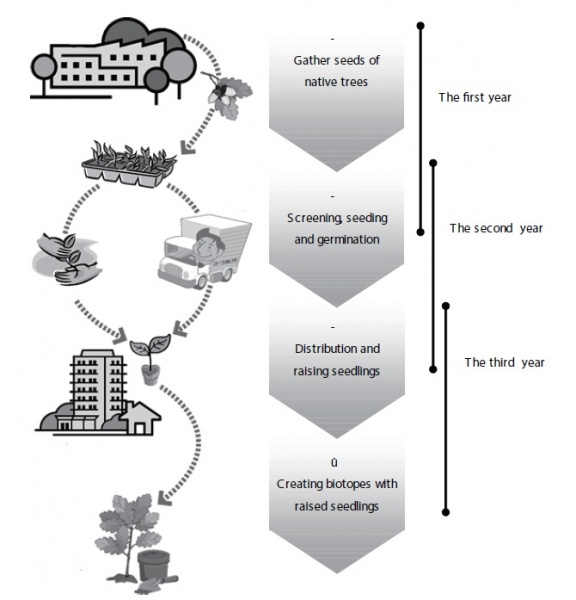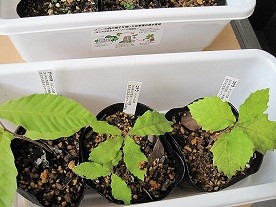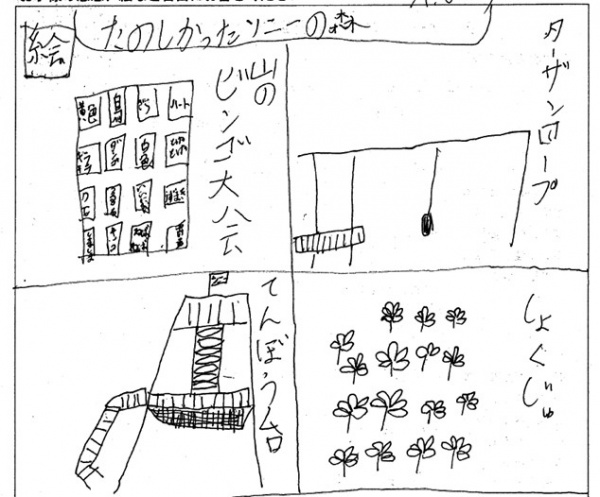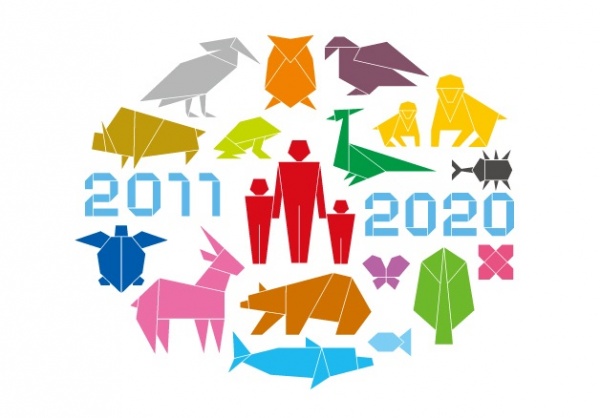Raising and planting native tree seedlings in local community of Aichi Prefecture, Japan
22.12.2015
-
SUBMITTED ORGANISATION :
-
Aichi Prefecture
-
DATE OF SUBMISSION :
-
22/12/2015
-
REGION :
-
Eastern Asia
-
COUNTRY :
-
Japan (Aichi Prefecture)
-
SUMMARY :
-
In March 2013, Aichi Prefecture adopted the Aichi Biodiversity Strategy 2020 in order to realize “Coexistence between People and Nature in Aichi”. The strategy contributes towards achieving the United Nation’s Strategic Plan for Biodiversity 2011-2020, especially “mainstreaming biodiversity” represented by Target 1, and “conservation habitats for living things” represented by Target 5, by establishing Ecological Network Councils organized by various local stakeholders in society, including citizens, companies, nonprofit organizations, universities and local governments in nine sub-regions within the Prefecture. One of the Councils, the Nishi-Mikawa Ecological Network Council has conducted the “Circulative Raising Native Tree Seedlings Project”: collecting seeds and raising seedlings through collaboration between companies, citizens and local governments, and creating biotopes in urban areas with the seedlings. The project aims at creating ecological networks by connecting nature in urban areas and enhancing “Satoyama” through the creation of biotopes in urban areas. It also provides environmental education opportunities to residents, through participation in the project. As a result, it is expected that awareness will be raised among stakeholders on “coexistence between people and nature”. This is the first step toward sustainable community building that considers regional characteristics and harmonizes the surrounding environment and ecosystem.
-
KEYWORD :
-
safeguarding ecosystem, genetic diversity, collaboration
-
AUTHOR:
-
Hitomi Horie, Natural Environment Division, Department of the Environment, Aichi Prefectural Government
Summary Sheet
The summary sheet for this case study is available here.
Introduction
In March 2013, Aichi Prefecture, located roughly in the center of the Japanese archipelago, adopted the Aichi Biodiversity Strategy 2020 in order to realize “Coexistence between People and Nature in Aichi” (Natural Environment Division of Aichi Prefectural Government, 2013). The strategy contributes toward achieving the United Nation’s Strategic Plan for Biodiversity 2011–2020, and, at the subnational level, Aichi Biodiversity Targets. From the perspective of a subnational government, Aichi in particular focuses on mainstreaming biodiversity represented by Target 1, “By 2020, at the latest, people are aware of the values of biodiversity and the steps they can take to conserve and use it sustainably (The Secretariat of the Convention on Biological Diversity, n.d.),” and conservation habitats for living things represented by Target 5, “By 2020, the rate of loss of all natural habitats, including forests, is at least halved and where feasible brought close to zero, and degradation and fragmentation is significantly reduced (The Secretariat of the Convention on Biological Diversity, n.d.),” of the Strategic Plan. Based on the Aichi Biodiversity Strategy 2020, Aichi Prefecture is promoting the establishment of regional councils organized by various local stakeholders in society, including citizens, companies, nonprofit organizations (NPOs), universities, and local governments within nine sub-regions. These councils are promoting biodiversity conservation.
One of the regional councils, the Nishi-Mikawa Ecological Network Council, is aiming to enhance the natural environment and local Satoyama area landscapes by creating ecological networks and connecting urban green spaces and Satoyama areas under the theme of “Aiming to Establish a Virtuous Living Cycle with the Latest Manufacturing and the Latest Ecology” (See Figure 1).
In order to achieve this purpose, the council has introduced the “Circulative Raising Native Tree Seedlings Project,” under which native tree seedlings are raised and planted to create more natural biotopes in urban areas, with guidance from ecologists.v

Figure 1. Image of creating an ecological network
The project also provides environmental education opportunities through participation in raising and planting the seedlings. The project could be replicated in other areas of Aichi through the creation of a technical manual that describes how to raise and plant seedlings.
In addition, it is important to maintain the original species and genes in a given area when undertaking ecological restoration and establishing ecological networks. The best way to prevent gene introgression is to use seeds collected from naturally grown trees. However, the amount of seed produced is small, and the shortage of seedlings is one of the major hurdles to creating ecological networks in the region. This project is designed to become one of the approaches used to resolve this problem. From these perspectives, the project is an approach designed to achieve better management of socio-ecological production landscapes (SEPLs).
Method
The Nishi-Mikawa region is located in the center of Aichi Prefecture. It is home to industrial clusters, including the automobile industry. Some companies promote cutting-edge environmental protection measures; moreover, citizens are willing to implement environmental activities such as creating biotopes and nature restoration. Local governments, not only the Aichi Prefectural Government but also cities and towns, including Toyota City and Okazaki City, also promote advanced environmental administration on the national scale, for example, forest management and
the prevention of global warming.
In the Nishi-Mikawa region, urban areas are located close to rice paddies in valleys and Satoyama areas. The latter consists mostly of secondary-growth forest and artificial forest of Japanese Cedar and Japanese Cypress planted after World War II. Recently, people have given up the management of Satoyama areas because of the reduced demand for firewood and other domestic wood requirements. In order to restore and conserve the Satoyama areas, it is necessary to consider new approaches to managing these areas that correspond to changing social circumstances.

Figure 2. Target area for planting native tree seedlings (ecosystem conservation society-japan, 2013)
Within the Nishi-Mikawa region, Aichi aims to create sustainable ecosystems, including cities, which strive to achieve a sustainable balance between nature and economic activities, and ensure preservation of the energy cycle in the area. The Nishi-Mikawa Ecological Network Council aims to contribute to this objective by creating ecological networks. The council was established by universities, companies, agriculture associations, forestry associations, NPOs, and local governments. Important features of the Circulative Raising Native Tree Seedlings Project are that companies play a central role as members of the council, and that the project involves the use of company properties. The project is led by Sony EMCS Corporation Kohda Site (hereinafter Sony EMCS) which maintains nature on its site in the Sony forest. The Japanese Consumers’ Co-operative Union Aichi called upon CO-OP AICHI, residents, specialists, and local governments (Aichi Prefecture, Okazaki City, and Kota Town), to collaborate on the project. “Creating a green industrial park has been an objective of Sony EMCS Corporation’s Kohda TEC since this manufacturing site was established” (Sony EMCS Corporation, 2015). Initially, employees of Sony EMCS planted trees to restore nature on its site, and have continued to maintain conservation efforts in hopes of creating a habitat for owls. CO-OP Aichi has held nature watching with its members and parents and children, the “CO-OP Aichi Forest,” and rice farming experiential activities and nature watching in collaboration with Japan Agricultural Cooperatives (the Japanese Consumers’ Co-operative Union Aichi, n.d.). It aims to establish a system that secures and supplies native tree seedlings for creating biotopes in urban areas. Areas proposed as planting sites are the Yahagi River Basin, Sakai River Basin, and Nagata River Basin (See Figure 2).
The Circulative Raising Native Tree Seedlings Project has one cycle of three years. A single cycle includes collecting seeds of native trees, screening, and seeding; distributing seedlings to residents; and planting and creating biotopes in urban areas using the seedlings raised by residents. Specialist surveys and studies are conducted at each stage. In order to deepen our understanding of how this Satoyama area works, study sessions are held during which seeds are collected, and seedlings are distributed and planted. Specialists have prepared a technical manual on seedlings, which includes descriptions of the seed bearing stage, screening method, raising method, and germination stage. At intervals, the Nishi-Mikawa Ecological Network Council conducts evaluation and monitoring (See Figure 3).

Figure 3. Flow chart of the Circulative Raising Native Tree Seedlings Project
Prior to the project, specialists selected trees suitable for the project. Firstly, they confirmed the vegetation zone of the forest from the potential natural vegetation zone based on an investigation of vegetation, birds, and insects. The forest comprises three forest types: evergreen, deciduous broad-leaved, and red pine. Secondly, specialists selected a deciduous broad-leaved forest where the seeds of main tree species could be collected with certainty. From the deciduous broad-leaved forest, they selected 20 tree species, including main tree species and characteristic tree species. Finally, 11 species were selected for the project based on seed distribution and seed-bearing capacity (See Table 1).
The investigation was implemented in 2012. Volunteers from the Sony EMCS Corporation collected and planted seeds as a trial. The project started in 2014, and by the end of the year, a manual was compiled that details the collection of seeds of native tree species, screening, and seeding as the first year action.
During the seed collecting stage, the Sony EMCS Corporation hosted an event for collecting native tree seeds and a study session. Volunteers from Sony EMCS and their families took part in the event. CO-OP AICHI notified its members, who also took part in the event, as did local government employees. The “Nature Watching and Seed Collection Event in Autumn” was held in October 2014 in the forest. Ninety-one people, including 32 children, participated in the event. Prior to the event, specialists monitored seed tree distribution and seed-bearing capacity. They also prepared a “nature bingo card” for nature watching, showing the types of nature that participants could see at the event. Participants were asked to seek certain aspects of nature, such as mushrooms or a good smell, etc., and completed the card, while having a great time. They also collected the seeds of nine native tree species, including Quercus glauca, Quercus serrata, and Eurya japonica, from among 20 native tree species. At the end of the event, specialists explained the next stages of the project, with the day’s event being the first step to restore the natural environment. They also explained that the collected seeds will be raised and planted in the local area, expanding the habitats for fauna and flora in the area.
A questionnaire relating to the event was handed out to the participants. One respondent said, “My child gathered acorns delightedly. The nature bingo card was great not only for my child but for us. Parents had more fun than our child.” One child said, “Some acorns were big, others were small, but both of them were pretty.” Another said, “I felt that a place for plants and insects to live is needed.” These answers revealed that many participants recognized the importance of nature.
Seeds were separated into nuts and fruits, and selected based on their shape. Various methods were used, for example, to eliminate pulp, fruits were soaked in water for several days, and then the seeds were picked out. Acorns were also soaked in water for several days, and those that floated in water or showed signs of insect damage were discarded. As a result, 60% of the collected seeds were available for seeding. A total of 2,104 pots were seeded and will be distributed in the second year of the project. At the end of the first year, the Nishi-Mikawa Ecological Network Council evaluated the project. As a consequence, certain future objectives were proposed, namely, the exchange of information on raising seedlings, collecting methods, and the selection of planting sites, and also preparation of a manual for children.

Table 1. Selection of native trees for the Circulative Raising Native Tree Seedlings Project (Ecosystem Conservation Society-Japan, 2013)

Figure 4. Distributed seedlings

Figure 5. A picture of the event drawn by a child
In spring 2015, 1,455 seeds—half of the seeds that were seeded in autumn 2014—had germinated (the germination rate was low; however, some of the species require two years for germination). Similar to the seed collecting event held in 2014, an event was held to distribute these small seedlings to local people for them to raise. Participants included 153 people, of which 68 were children. Five species of native tree seedlings, including Quercus serrata and Vaccinium bracteatum, are suitable for raising by local people. To each participant, 6 to12 small seedlings were handed over.
The event included nature watching and planting seedlings that volunteers of Sony EMCS had collected as seeds in 2013 and raised in the Sony forest. In addition to the event, we requested the assistance of local elementary schools and junior high schools in raising seedlings. Some of the schools accepted; in particular, a few elementary schools told us that they would raise the seedlings as part of their environmental education curriculum. We also distributed the seedlings to local people through a junior high school event. A satoyama management group, which is active around Sony forest, supported our project and agreed to cooperate with us. Along with the seedlings, we gave people a leaflet describing how to raise the seedlings. In addition to these activities, we collected seeds of Prunus jamasakura in early summer and these were seeded in the autumn. This stage will be led by CO-OP AICHI and local governments.
When native tree seedlings grow large enough for planting, seedlings are gathered and planted. The tree planting sites will be located in three types of areas. The first is a Satoyama area. The second type is at biotopes created during landscaping by local governments and companies. The third will be at a biotope creating event, so as to raise awareness on the meaning of biodiversity and ecological networks. Moreover, seedlings will be planted in backyards by volunteers and members of CO-OP AICHI, who have raised native tree seedlings. Local elementary schools are suitable for creating biotopes with seedlings. This will be the third-year action of the project.
The Circulative Raising Native Tree Seedlings Project will establish a process from collecting seeds to planting. At the same time, it will expand areas of the target native tree species. The greater the number of tree species the project targets, the more detail will be written in the manual. In addition, target areas will include other sub-regions in Aichi, as well as in the Nishi-Mikawa region.
Expected results
Native tree seedlings prevent gene introgression in the creation of biotopes in urban areas; however, a supply shortage of seedlings is a problem. It can be expected that the Circulative Raising Native Tree Seedlings Project will establish and ensure a stable supply system of native tree seedlings through the collection of seeds for planting. Moreover, a technical manual was prepared for this process. This will ensure that knowledge of and the know-how to raise native tree seedlings is accumulated. When a new similar project starts, it will thus be easy to share knowledge and know-how. For this reason, this project will hopefully stimulate other stakeholders in other areas of Aichi to start similar projects to raise native tree seedlings.
Through volunteers from a private company and appeals from CO-OP AICHI, citizens, including children, take part in each stage of the project: seed collection, raising seedlings and planting seedlings. Nature watching is held on the occasions of seed collection, seedling distribution, and planting. In other words, the project provides environmental education opportunities. According to the above-mentioned questionnaire, participants understood the importance of nature, and learned about nature restoration. It shows that opportunities to get in touch with nature make people more concerned about local nature. Hence, citizens are expected to be aware of participation in nature restoration and conservation activities through such projects.
Progress on the Circulative Raising Native Tree Seedlings Project is periodically reported to the Nishi-Mikawa Ecological Network Council, with discussion on how to promote it and deal with future challenges, based on each member’s views. Information on demand and supply of seedlings and planting sites is shared at Council meetings.
Moreover, it is anticipated from a sustainability point of view that Satoyama areas will be managed as part of an economic system. For example, the Satoyama Vision of the Nishi-Mikawa Ecological Network Council has proposed creating a new management system of Satoyama areas as one of its basic policies. Satoyama areas include artificial forest of planted Japanese Cedar and Japanese Cypress; however, people have given up the management of this type of forest. In order to manage it, cutting down artificial forest and restoring broadleaf forest is one example of a management system for biodiversity. In this case, the best way to treat wood is by adding economic value through utilizing it as woody biomass or timber.
Expected lessons
The establishment of a system promotes the participation of various sectors of the community, including citizens, in the project. Compiling a technical manual on raising seedlings is one example of a means to promote participation. The Nishi-Mikawa Ecological Network Council has two roles in the project. One is as an information hub; the other is as a database. Through sharing information and collaboration, participants enhance awareness of the co-management of Satoyama area landscapes. As a result, it is expected that the creation of biotopes in urban areas using seedlings from Satoyama areas may foster links between people.
Due to a decrease in the economic value of Satoyama area, there has been a progressive decline in its management. On the other hand, a new management method, which is compatible with today’s society, such as environmental education, is required. In the Circulative Raising Native Tree Seedlings Project, seed collection is implemented as an event, with the participation of volunteers and their families from the Sony EMCS Corporation. Since COOP AICHI also participates in the project, it calls for its members’ participation in the event. Consequently, citizens participate in the project. This means that collaboration between stakeholders provides citizens with opportunities to join in nature conservation activities. Collecting seeds and raising seedlings are activities suitable for citizens, including children, and provide opportunities to learn about the environment. The project is expected to raise awareness that growing native tree seedlings is one of the steps toward the conservation of local nature and ecosystems, and can thus trigger an interest in local nature. Moreover, interest in the local natural environment promotes a sense of affiliation with the place where people live. “Coexistence between people and nature” is a precious step in the establishment of community and the happiness of its citizens.
Another result is the efficiency of collaboration among various stakeholders in raising native tree seedlings and creating biotopes. In the collaboration process, key elements are opinion exchange, sharing of information, and the establishment of trustworthy relationships. These elements require some time.
The Circulative Raising Native Tree Seedlings Project still faces future challenges. Once a supply system of native tree seedlings is established as a model, the next questions are whether it is a sustainable system or not, and how to expand the system to other areas. Matching the demand and supply of native tree seedlings is a key point in meeting these challenges. In this regard, the Nishi-Mikawa Ecological Network Council plays the role of coordinator. In terms of expanding the project, one contingency plan is creating a separate manual for different target audiences, such as children and adults. Another is appointing an educator who has knowledge of raising native tree seedlings to participate in a new project. In this case, the Nishi-Mikawa Ecological Network Council would coordinate the sharing of a lot of information among stakeholders. The more people who participate in the project, the stronger will be the supply system of native tree seedlings. Furthermore, the establishment of an economic Satoyama area management system will support expansion of the system.
Conclusion
The Circulative Raising Native Tree Seedlings Project in the Nishi-Mikawa region is a system designed to supply seedlings that takes into consideration genetic diversity and seeks to promote the stable and continuous creation of biotopes in urban areas. The project promotes connecting nature between urban areas and Satoyama, without forgetting its importance in a changing society, by means of creating ecological networks with various stakeholders’ collaboration.
In the project, citizens collect native tree seeds, raise seedlings, and create biotopes around their homes using these seedling, with assistance being provided by NPOs, companies, and local governments. It is expected that these activities will help citizens to recognize the meaning of nature restoration in urban areas and provide an understanding of the ecological networks created through their activities. Furthermore, it is also expected that the project will raise awareness on “coexistence with nature”. Raising seedlings and nature watching are good opportunities to turn environmental education into enlightenment.
As a result, two results are expected. One is realizing “coexistence between people and nature,” since various local stakeholders expressed interest in nature in the area, and the other is taking action to conserve nature where people live. A further consequence of the project is nurturing a love of the places where people live, work, and learn. These aspects contribute to realizing “Coexistence Between People and Nature in Aichi” of the Aichi Biodiversity Strategy 2020.
The Circulative Native Tree Seedlings Project connects growing cities and Satoyama areas with nature, and enlarges habitats for various life forms in suitable locations. Thus, overall, the project contributes to biodiversity conservation. The project is a step toward sustainable community building that considers regional characteristics, and is in harmony with the surrounding environment and ecosystems.

Figure 6: Seeding (Photo by ecosystem conservation society-japan, 2014)

Figure 7: Satoyama in Aichi (Photo by Sony EMCS, 2015)
Acknowledgements

The project has been approved by the Japan Committee for United Nations Decade on Biodiversity (UNDB-J) as a partnership project. (UNDB-J, 2012)
References
Ecosystem Conservation Society-Japan (2013) Aichi Investigation Report of Promoting Symbiotic Society, Aichi Prefectural Government
Ecosystem Conservation Society-Japan (2014) Sony forest
Natural Environment Division, Department of the Environment of Aichi Prefectural Government, (2013) Aichi Biodiversity Strategy 2020, Aichi Prefectural Government
Sony EMCS Corporation (2015) Sony’s ecology. For a Greener Future viewed July 24, 2015 <http://www.sony.net/SonyInfo/csr/ForTheNextGeneration/ecology/efforts/communication/01.html>
Sony EMCS Corporation (2014) Sony forest The Japan Committee for United Nations Decade on Biodiversity (2012)
The Japanese Consumers’ Co-operative Union Aichi (n.d.) A Record of Environmental Activities viewed July 24, 2015 <http://www.coop-aichi.jp/activity/abouteco/eco-histry/>
The Secretariat of the Convention on Biological Diversity (n.d.) Aichi Biodiversity Target, viewed February 17, 2014,<http://www.cbd.int/sp/targets/>

